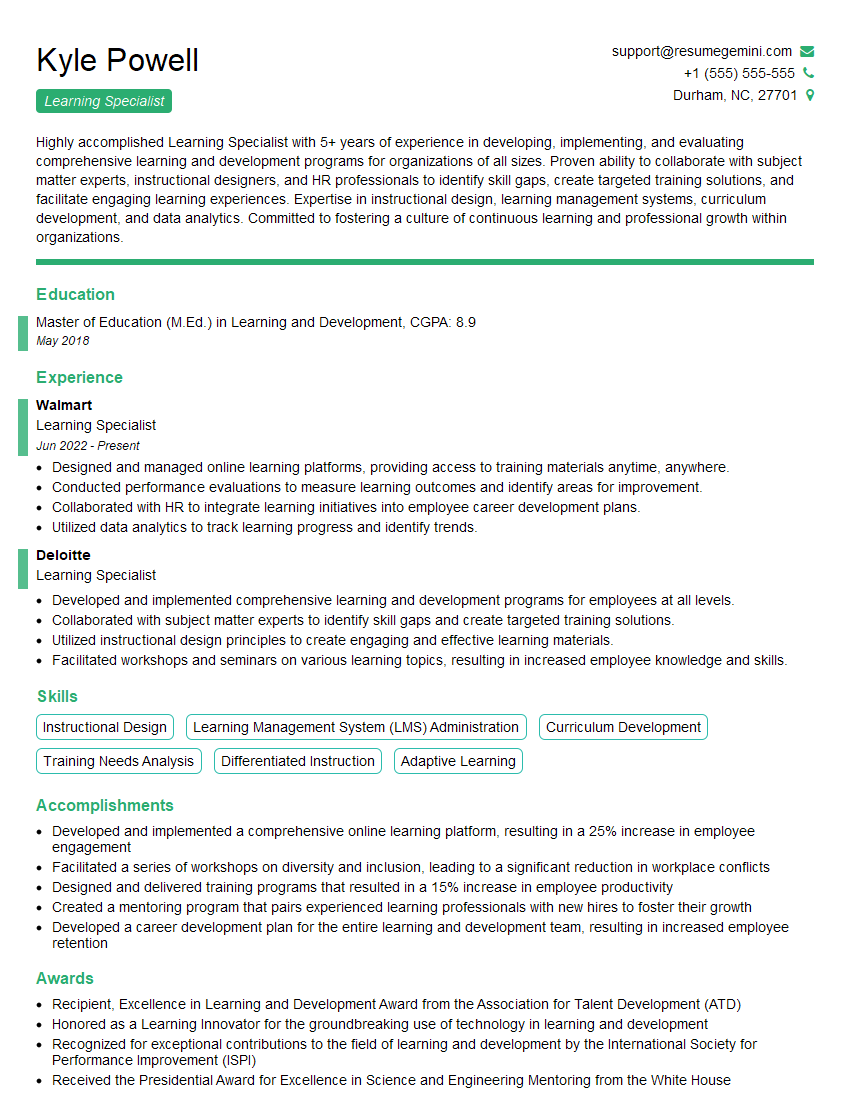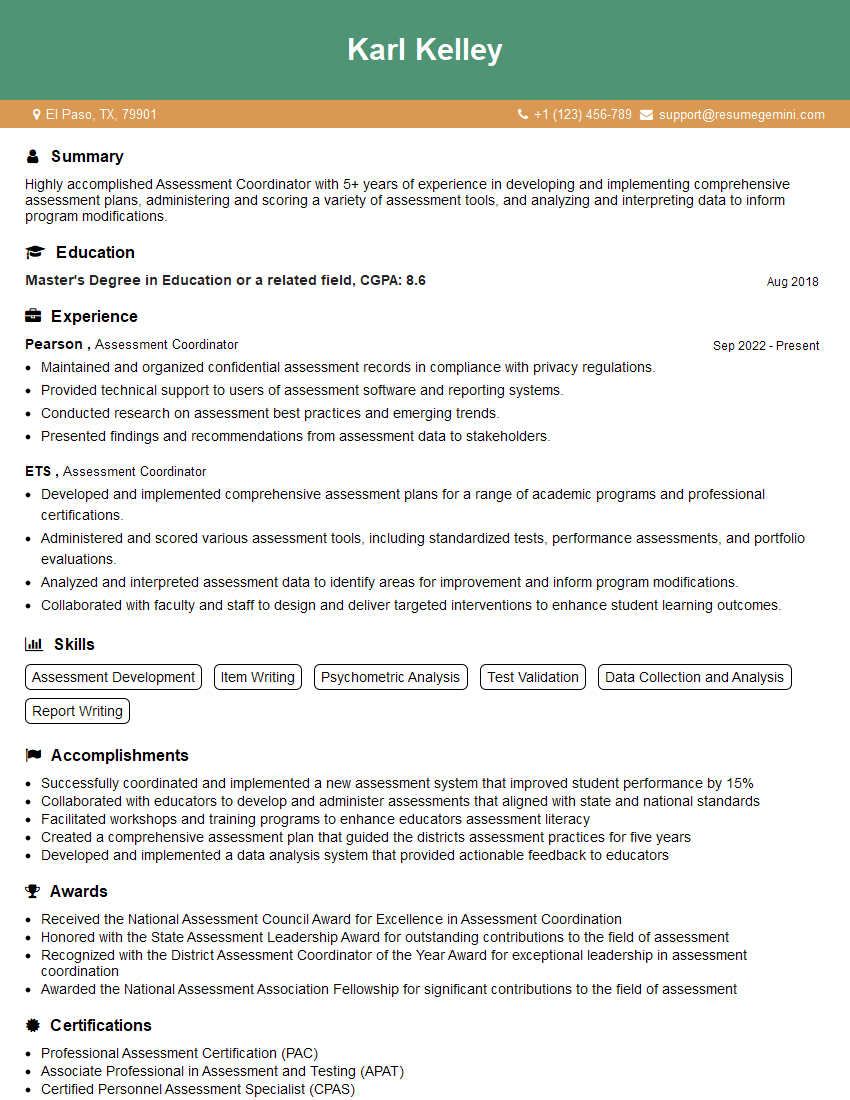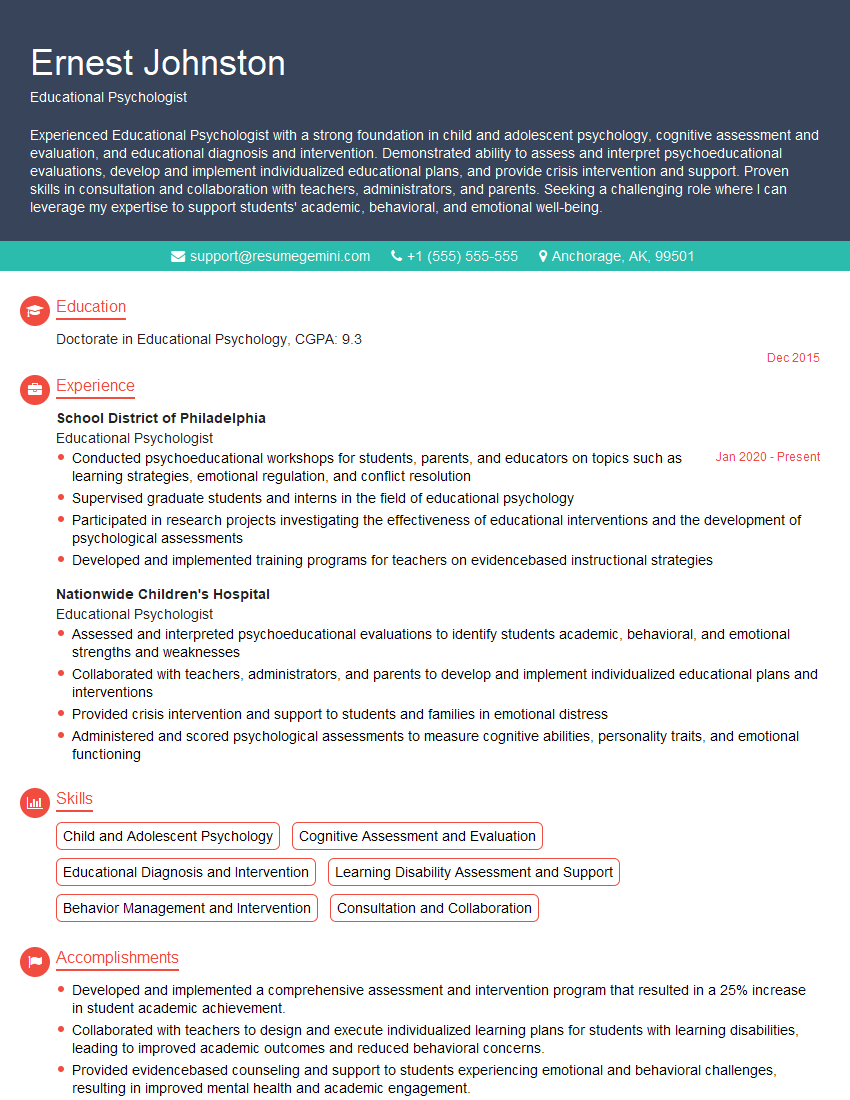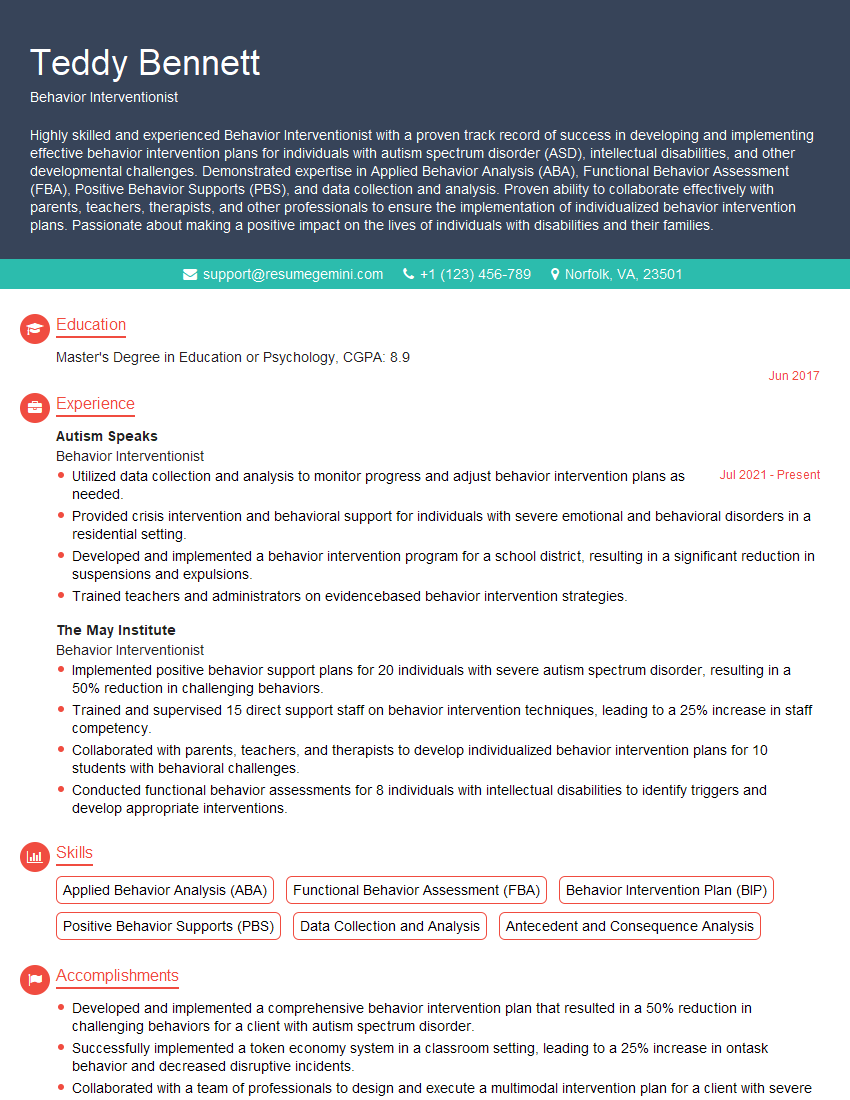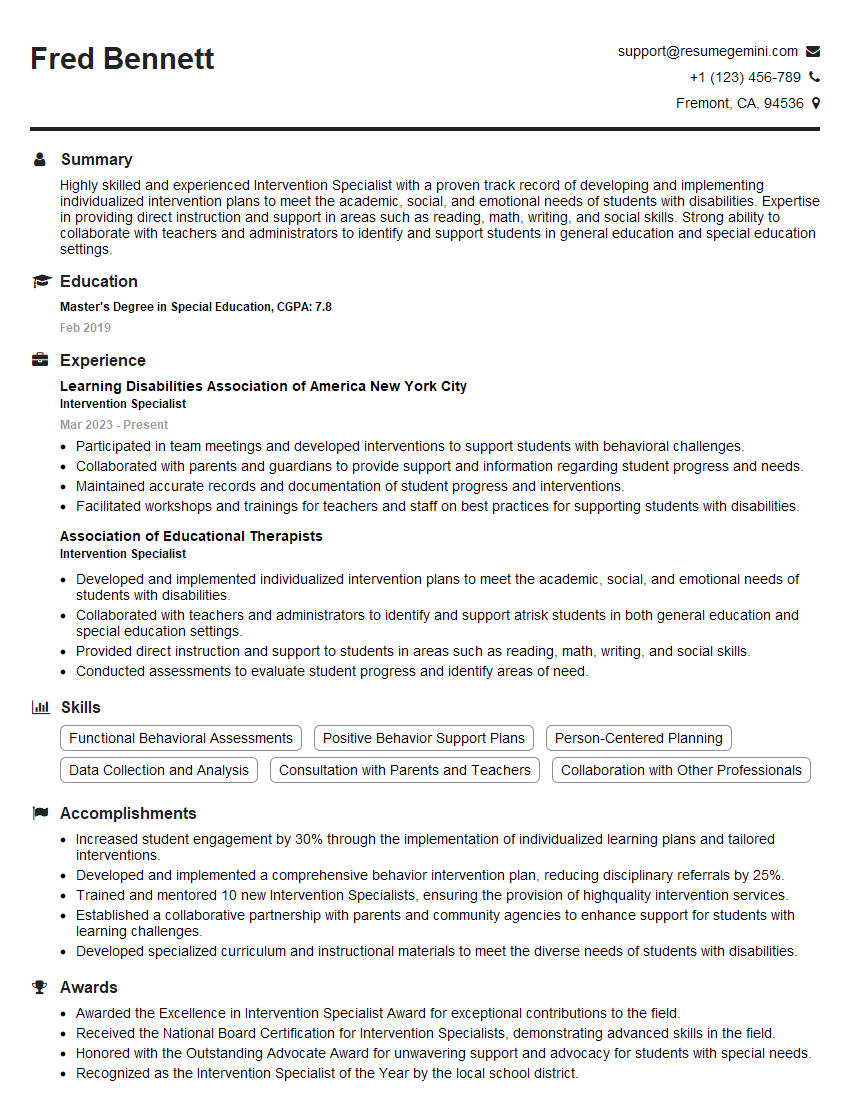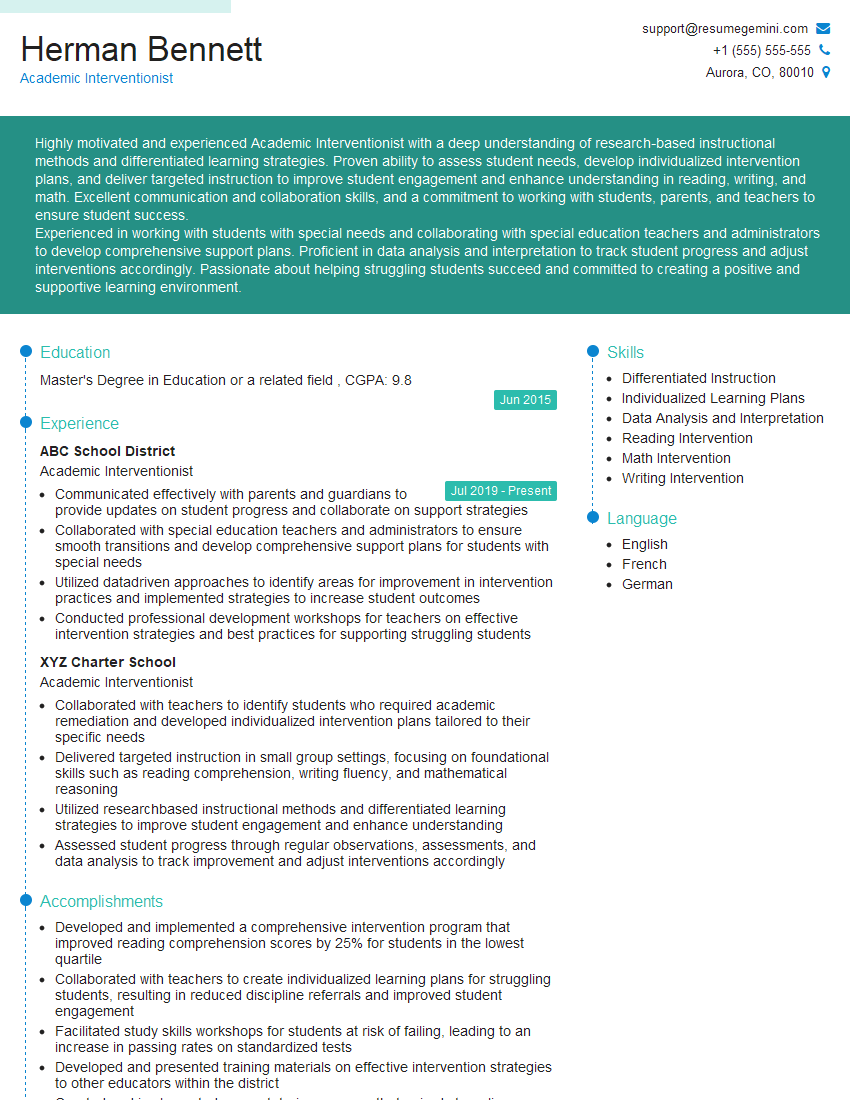Interviews are opportunities to demonstrate your expertise, and this guide is here to help you shine. Explore the essential School Psychology Assessment and Intervention interview questions that employers frequently ask, paired with strategies for crafting responses that set you apart from the competition.
Questions Asked in School Psychology Assessment and Intervention Interview
Q 1. Describe your experience administering and interpreting the WISC-V.
Administering the WISC-V involves carefully following standardized procedures to ensure accurate and reliable results. This includes establishing rapport with the child, explaining the tasks clearly, and meticulously recording responses. Interpretation goes beyond simply looking at the final scores; it involves a comprehensive analysis of the child’s performance across different subtests, considering their strengths and weaknesses in various cognitive domains. For example, a child might score highly on verbal comprehension but struggle with processing speed. This would indicate a need for tailored interventions focusing on improving their processing speed, while leveraging their verbal strengths. I analyze the Full Scale IQ (FSIQ), as well as the four index scores (Verbal Comprehension, Visual Spatial, Fluid Reasoning, and Processing Speed), alongside subtest scores to build a complete profile of the child’s cognitive abilities. I then integrate this information with other assessment data and observations to create a holistic understanding of the child’s learning needs. I always consider the context of the child’s life, including their educational environment and home life, to ensure a valid interpretation.
For instance, I recently assessed a student who scored well above average on the Verbal Comprehension Index but significantly below average on the Processing Speed Index. This suggested that while the student had strong verbal abilities, their ability to quickly process information was significantly hindering their academic performance. This finding informed recommendations for specific classroom accommodations and interventions to help the student succeed academically.
Q 2. Explain the difference between formative and summative assessment in a school setting.
Formative and summative assessments serve distinct purposes in evaluating student learning. Formative assessments are ongoing, low-stakes evaluations used to monitor student progress and guide instruction. Think of them as ‘check-ins’ throughout the learning process. Examples include quizzes, exit tickets, and class discussions. They provide immediate feedback to both the student and the teacher, allowing for adjustments to teaching strategies and learning support. Summative assessments, on the other hand, are high-stakes evaluations that measure a student’s overall learning at the end of a unit, term, or year. Examples include final exams, standardized tests, and major projects. They provide a snapshot of what a student has learned and often contribute significantly to their grade.
Imagine teaching a unit on fractions. Formative assessments would involve short quizzes after each lesson, allowing me to address any misconceptions immediately. The summative assessment would be a larger test at the end of the unit measuring mastery of all fraction concepts. This combination provides a balanced approach, ensuring both ongoing monitoring and a final evaluation of learning.
Q 3. How do you identify and address learning disabilities using various assessment tools?
Identifying learning disabilities requires a multi-faceted approach. It’s not enough to rely on one assessment; a comprehensive evaluation is crucial. I use a variety of tools, including achievement tests (like the WIAT-4) to measure academic skills, intelligence tests (like the WISC-V) to assess cognitive abilities, and behavioral observations to understand the student’s learning style and classroom behavior. Discrepancies between a student’s cognitive abilities and their academic achievement can be a key indicator of a learning disability. For example, a student who has average intelligence but significantly below-average reading scores might have a specific learning disability in reading. I also utilize informal assessments like curriculum-based measurements (CBMs) which help in monitoring progress in specific academic skills throughout the school year.
Once a learning disability is suspected, I work collaboratively with the student’s teachers and parents to develop an individualized education program (IEP) that addresses their unique needs. This plan might include accommodations like extended time on tests, assistive technology, or specialized instruction. The key is to address the underlying cognitive or processing deficits to help the student learn effectively.
Q 4. What are your preferred strategies for behavior intervention plans (BIP)?
My preferred strategies for Behavior Intervention Plans (BIPs) are rooted in a positive behavioral support (PBS) framework. This means focusing on teaching positive behaviors rather than just punishing negative ones. A BIP should be proactive, teaching replacement behaviors for challenging ones. I start with a Functional Behavior Assessment (FBA) to understand the function of the behavior – what the student is getting out of it (attention, escape, access to something). This information informs the development of effective interventions.
I favor strategies that are individualized, data-driven, and focus on prevention. This might include teaching self-regulation skills, creating positive reinforcement systems, and modifying the environment to reduce triggers for challenging behaviors. For example, if a student is exhibiting disruptive behaviors to get attention, the BIP might involve teaching the student alternative ways to get attention (raising their hand, asking for help) and rewarding those positive behaviors consistently. Regular monitoring and data collection are vital to ensure the BIP is effective and adjustments are made as needed.
Q 5. Describe your experience with Functional Behavior Assessments (FBAs).
Functional Behavior Assessments (FBAs) are crucial for understanding the underlying causes of challenging behaviors. They involve collecting information through various methods, including direct observation, interviews with teachers and parents, and review of school records. The goal is to identify the antecedents (what happens before the behavior), the behavior itself, and the consequences (what happens after the behavior). This helps determine the function of the behavior. For example, an FBA might reveal that a student is acting out because they are struggling with a specific academic task (antecedent) and that the consequence is being sent out of the classroom (escape).
I use a variety of techniques to conduct FBAs, including direct observation using ABC data sheets (recording Antecedent, Behavior, Consequence) and indirect assessments like interviews and questionnaires. This information is then used to create a BIP that addresses the function of the behavior. I strongly believe in involving the student, family, and teachers in the FBA process, as their insights are invaluable.
Q 6. How do you collaborate with teachers and parents to implement interventions?
Collaboration is paramount in implementing effective interventions. I believe in a team approach involving teachers, parents, and the student themselves. I initiate this process through regular meetings and open communication. This collaboration begins with clearly explaining the assessment results and intervention plans in easily understood terms, avoiding technical jargon. For teachers, I provide practical strategies and resources to implement interventions in the classroom. For parents, I emphasize the importance of consistency between the home and school environments. This requires regular communication, feedback, and adjustments to the intervention plan as needed. Finally, involving the student, when appropriate to their developmental level, helps increase their buy-in and success.
For example, when collaborating with a teacher to implement a BIP, we might agree on specific classroom strategies, such as providing visual schedules or frequent check-ins, while I provide ongoing support and monitoring. Open communication and regular data sharing with parents help ensure consistency and progress tracking.
Q 7. Explain your approach to working with students with emotional and behavioral disorders.
Working with students with emotional and behavioral disorders (EBD) requires a multifaceted approach that addresses both the academic and emotional needs of the student. My approach is based on building a strong therapeutic relationship with the student, fostering trust and understanding. This involves actively listening to their concerns, validating their feelings, and creating a safe and supportive environment. I utilize evidence-based interventions, tailored to the student’s specific needs. This may include cognitive behavioral therapy (CBT) to help students manage their emotions and behaviors, social skills training to improve their interactions with peers, and strategies to enhance their self-regulation skills. Collaboration with parents and teachers is vital, ensuring a consistent and supportive environment both at school and at home.
For instance, I worked with a student who frequently experienced anger outbursts. Through CBT, we identified triggers for their anger and developed coping mechanisms, such as deep breathing exercises and positive self-talk. This, coupled with strategies implemented in the classroom and at home, significantly reduced the frequency and intensity of their outbursts.
Q 8. Describe your experience with students with ADHD, including assessment and intervention strategies.
My experience with students with ADHD encompasses a wide range of assessment and intervention strategies. ADHD, or Attention-Deficit/Hyperactivity Disorder, presents unique challenges in the academic setting, impacting attention, impulsivity, and hyperactivity. Assessment begins with a thorough review of the student’s history, including academic records, teacher observations, and parent interviews. I utilize standardized measures like the Conner’s rating scales and the WISC-V (Wechsler Intelligence Scale for Children – Fifth Edition) to objectively assess cognitive abilities and behavioral patterns. I also often use behavioral rating scales to gather information from parents and teachers.
Intervention strategies are tailored to the individual student’s needs and may include behavioral interventions like positive reinforcement systems, self-monitoring techniques, and organizational strategies. For example, I might work with a student and teacher to implement a token economy system where positive behaviors earn points towards a reward. Academic interventions might focus on strategies to improve attention, such as breaking down tasks into smaller, manageable chunks, using visual aids, and providing frequent breaks. Collaboration with parents and teachers is critical to ensure consistency across settings. I also consider the use of medication, always emphasizing the importance of a multi-modal approach that combines medication with behavioral and academic support.
For instance, I recently worked with a student who struggled immensely with inattention and impulsivity. Through comprehensive assessment, we identified his specific learning challenges. We implemented a combination of strategies including a structured classroom environment, regular check-ins, visual organizers, and a personalized reward system. The result was a significant improvement in his academic performance and classroom behavior.
Q 9. How do you utilize data to inform instructional decisions?
Data-driven decision making is fundamental to effective school psychology practice. I utilize various data sources, including standardized test scores, curriculum-based assessments (CBAs), teacher observations, and behavioral data, to inform instructional decisions. CBAs provide frequent, short measures of academic skills that allow for monitoring of student progress in response to instruction. For example, I might use a CBA to track a student’s fluency in reading. If the data shows a lack of progress, it informs the need for more intensive intervention.
I use data to identify students who are at risk for academic failure or who are not responding adequately to instruction. This data then allows us to modify our instructional practices and select interventions that are specifically targeted to address the student’s needs. Regular data analysis ensures that interventions are effective and adjustments are made as needed. Think of it like navigating with a GPS – the data provides feedback and helps us adjust our course to reach the desired destination (academic success). I often use spreadsheets or data visualization tools to track and analyze this data, making it easily accessible and shareable with parents and teachers.
Q 10. What is your experience with Response to Intervention (RTI) models?
Response to Intervention (RTI) is a multi-tiered framework designed to provide early intervention and support to students who are struggling academically or behaviorally. My experience with RTI models involves working within multi-tiered systems of support (MTSS) which incorporate RTI. This generally involves three tiers: Tier 1 is universal instruction, provided to all students. Tier 2 provides targeted interventions for students who aren’t responding to Tier 1. Tier 3 involves intensive, individualized interventions for students who require more extensive support.
My role includes contributing to the development and implementation of RTI models, conducting assessments to identify students who need support at different tiers, collaborating with teachers to design and implement interventions, and monitoring student progress. I use data from various sources, including CBAs and behavioral data, to track student response to intervention and to inform decisions about moving students between tiers. A key element of RTI is progress monitoring, which is essential for ensuring that interventions are effective and to make necessary adjustments. The goal is to prevent students from falling too far behind and to provide support as early as possible.
Q 11. How do you conduct a comprehensive psychoeducational assessment?
A comprehensive psychoeducational assessment is a multifaceted process that aims to understand a student’s strengths and weaknesses academically, cognitively, and emotionally. It’s a puzzle, and we’re piecing together the various aspects to get a complete picture. It starts with a referral, which usually describes the presenting problem or area of concern. The assessment then involves several steps:
- Gathering information: This involves reviewing school records, conducting interviews with parents, teachers, and the student, and obtaining relevant medical information.
- Cognitive assessment: Using standardized intelligence tests (like the WISC-V or Stanford-Binet) to measure cognitive abilities, including verbal and nonverbal skills, processing speed, and working memory. This provides a baseline understanding of the student’s cognitive functioning.
- Academic achievement assessment: Using standardized achievement tests (like the Woodcock-Johnson IV) to evaluate skills in reading, math, and writing. This reveals areas of academic strength and weakness.
- Behavioral and emotional assessment: Using behavioral rating scales, observations, and sometimes projective measures to assess emotional and behavioral functioning, looking for signs of anxiety, depression, or other mental health conditions. This often involves parental and teacher perspectives.
- Integration and interpretation: The results from all these sources are combined to form a comprehensive profile of the student’s strengths and challenges. This profile is used to generate hypotheses about the student’s difficulties and make recommendations for interventions and support.
The ultimate goal is to develop recommendations that are evidence-based and tailored to the student’s unique needs. These recommendations can include academic accommodations, behavioral interventions, and referrals to other specialists if needed.
Q 12. Describe your knowledge of different types of standardized tests used in school psychology.
School psychologists utilize a variety of standardized tests, each designed to assess different aspects of a student’s functioning. These include:
- Intelligence tests: WISC-V (Wechsler Intelligence Scale for Children – Fifth Edition), Stanford-Binet Intelligence Scales, Kaufman Assessment Battery for Children (KABC-II).
- Achievement tests: Woodcock-Johnson IV Tests of Achievement, Wechsler Individual Achievement Test – Fourth Edition (WIAT-IV), KeyMath-3.
- Behavioral and emotional tests: Conner’s Rating Scales, Behavior Assessment System for Children (BASC-3), Child Behavior Checklist (CBCL).
- Specific learning disability tests: Test of Written Language-4 (TOWL-4), Test of Auditory Processing Skills (TAPS-4), Woodcock-Johnson Tests of Cognitive Abilities (WJ-Cog).
The selection of appropriate tests depends on the student’s age, presenting problems, and the specific questions being asked. It’s crucial to understand the psychometric properties of each test, such as reliability and validity, to ensure accurate and meaningful interpretations.
Q 13. What are your ethical considerations when conducting assessments and interventions?
Ethical considerations are paramount in all aspects of school psychology assessment and intervention. My practice is guided by the ethical principles outlined by the National Association of School Psychologists (NASP). Key considerations include:
- Confidentiality: Maintaining the confidentiality of student information is essential, sharing information only with those who have a legitimate need to know and obtaining appropriate consent.
- Informed consent: Ensuring that parents and students (when appropriate) understand the purpose, procedures, and potential risks and benefits of assessments and interventions before they are conducted.
- Competence: Only undertaking assessments and interventions within my area of expertise and seeking supervision or consultation when needed.
- Cultural sensitivity: Being aware of and addressing potential cultural biases in assessment and intervention practices. Not relying on tests that are not norm-referenced appropriately for a given population.
- Fairness and objectivity: Striving to be fair and objective in my assessments and recommendations, avoiding biases that could impact my judgments.
- Integrity: Maintaining the integrity of the assessment process by following standardized procedures and accurately reporting results.
Ethical dilemmas may arise, and when they do, I adhere to NASP’s ethical guidelines and seek consultation when necessary to ensure that I’m making ethically sound decisions.
Q 14. How do you ensure culturally responsive assessment and intervention practices?
Culturally responsive assessment and intervention practices are crucial for providing equitable and effective services to all students. It means acknowledging that students come from diverse backgrounds and experiences that significantly impact their learning and behavior. This is not just about ethnicity, but also socioeconomic status, language background, and cultural values.
To ensure culturally responsive practices, I use a variety of strategies:
- Using culturally appropriate assessment tools: Selecting assessments that are normed on diverse populations and minimizing the use of tests that may be culturally biased. Considering the language proficiency of the student and using interpreters when necessary.
- Considering cultural context: Interpreting assessment results within the context of the student’s cultural background, acknowledging that behaviors that might be considered problematic in one culture could be acceptable in another.
- Building rapport: Developing a strong rapport with students and their families by demonstrating respect, understanding, and empathy for their cultural values and beliefs.
- Collaborating with families: Collaborating with families to understand their perspectives and incorporate their knowledge and values into assessment and intervention planning.
- Utilizing culturally responsive interventions: Designing and implementing interventions that are sensitive to the cultural context of the student and that build on their strengths and resources.
For instance, I worked with a student from a specific cultural background where direct eye contact was considered disrespectful. By understanding this aspect of their culture, I adjusted my interaction style during assessment, building a more positive and effective rapport.
Q 15. How do you prioritize cases and manage your time effectively?
Prioritizing cases and managing time effectively as a school psychologist requires a multifaceted approach. I use a combination of strategies, including:
Triaging based on urgency and severity: Students facing immediate safety risks or significant academic/behavioral disruptions are prioritized. I utilize a tiered system, addressing the most pressing needs first.
Utilizing data-driven decision making: I analyze assessment data, teacher referrals, and progress monitoring data to inform prioritization. This ensures that interventions are targeted and effective.
Time blocking and scheduling: I allocate specific time slots for different tasks, such as assessments, report writing, IEP meetings, and direct student interventions. This helps maintain focus and prevents tasks from overlapping.
Delegation and collaboration: When appropriate, I delegate tasks to support staff (e.g., paraprofessionals) to maximize my time spent on high-priority interventions. Collaboration with teachers and parents is key to efficient case management.
Regular review and adjustment: I regularly review my schedule and caseload to ensure that my time is being used effectively. I am flexible and willing to adjust my approach as needed.
For example, if a student is exhibiting self-harm behaviors, that case would immediately take precedence over a student with mild learning difficulties. This system allows for efficient allocation of resources and ensures that students with the most pressing needs receive timely support.
Career Expert Tips:
- Ace those interviews! Prepare effectively by reviewing the Top 50 Most Common Interview Questions on ResumeGemini.
- Navigate your job search with confidence! Explore a wide range of Career Tips on ResumeGemini. Learn about common challenges and recommendations to overcome them.
- Craft the perfect resume! Master the Art of Resume Writing with ResumeGemini’s guide. Showcase your unique qualifications and achievements effectively.
- Don’t miss out on holiday savings! Build your dream resume with ResumeGemini’s ATS optimized templates.
Q 16. Describe a time you had to adapt your approach to meet the needs of a specific student.
I once worked with a student, Alex, who was diagnosed with ADHD and struggled significantly with executive functioning skills. My initial approach, which focused on traditional behavioral interventions, yielded minimal results. Alex became increasingly frustrated and withdrawn. I realized I needed to adapt my approach.
I collaborated closely with Alex’s parents and teachers to gather more information about his learning preferences and his social-emotional needs. We discovered that Alex thrived in hands-on, kinesthetic learning environments. He also had a strong interest in computers and technology.
I adapted my intervention strategy by incorporating technology-based learning tools and incorporating movement and active learning techniques into his lessons. We also implemented a visual schedule to help him better manage his time and tasks. This adapted approach significantly improved Alex’s engagement, focus, and academic performance. His self-esteem also increased as he felt more successful in school.
Q 17. How do you maintain confidentiality in your work with students and their families?
Maintaining confidentiality is paramount in my work. I adhere strictly to ethical guidelines and legal regulations, such as FERPA (Family Educational Rights and Privacy Act). My practices include:
Secure storage of records: All student records, including assessment results and intervention plans, are stored in locked cabinets and electronic systems with secure access controls.
Limited access to information: I only share information with authorized personnel, such as parents (with student consent when appropriate), teachers, and other members of the IEP team. I always obtain explicit consent before disclosing any information.
Confidential communication: I use secure communication methods when discussing student information, such as encrypted email or secure messaging platforms.
Adherence to HIPAA: If dealing with health information, I also strictly adhere to HIPAA regulations.
Professional boundaries: I maintain professional boundaries in all interactions with students and families, ensuring that discussions remain focused on relevant school-related matters.
For example, I would never discuss a student’s case with another colleague unless it was directly related to providing services to that student and only with the appropriate consent forms in place. Maintaining trust and confidentiality builds strong relationships with students and their families.
Q 18. Explain your experience working with an IEP team.
I have extensive experience collaborating with IEP (Individualized Education Program) teams. My role typically involves:
Conducting comprehensive assessments: I administer and interpret various assessments to identify a student’s strengths and weaknesses, including cognitive abilities, academic skills, social-emotional functioning, and adaptive behavior.
Participating in IEP meetings: I actively participate in IEP meetings, sharing my assessment findings, recommending appropriate interventions, and collaborating with the team to develop individualized goals and strategies.
Developing and implementing intervention plans: I help create and implement evidence-based interventions to address the student’s identified needs, monitoring progress closely and making adjustments as necessary.
Providing professional development: I often provide professional development to teachers and other team members on topics relevant to the student’s needs, such as strategies for working with students with specific learning disabilities or behavioral challenges.
Advocating for student needs: I advocate for the student’s needs within the IEP process, ensuring that the team develops a plan that aligns with the student’s strengths and challenges and maximizes their potential for success.
For instance, I recently worked with an IEP team to develop a plan for a student with autism spectrum disorder. My assessment results helped to identify the student’s specific communication and social skills deficits, which informed the team’s decision to include social skills training and augmentative and alternative communication (AAC) strategies in the IEP.
Q 19. How do you facilitate communication between home and school?
Facilitating effective communication between home and school is crucial for student success. I employ various strategies to achieve this:
Regular communication with parents: I maintain regular contact with parents through phone calls, emails, and parent-teacher conferences. I provide updates on the student’s progress and solicit feedback from parents.
Parent-teacher conferences: I actively participate in parent-teacher conferences to discuss the student’s progress, challenges, and intervention plans. This collaborative approach ensures that everyone is on the same page.
Utilizing communication tools: I utilize school communication platforms (e.g., email, learning management systems) to share information efficiently and keep parents informed about upcoming events and deadlines.
Parent workshops and training: I conduct workshops or training sessions for parents on topics relevant to their child’s needs and how they can support learning at home. This empowers parents to be active participants in their child’s education.
Home-school communication notebooks: In some cases, I utilize home-school communication notebooks to facilitate daily communication between school and home regarding the student’s behavior and progress.
A successful example involved a student struggling with anxiety. By regularly communicating with the parents about coping strategies and providing resources, we created a supportive home and school environment that helped the student manage their anxiety effectively.
Q 20. What are your strategies for supporting students’ social-emotional learning?
Supporting students’ social-emotional learning (SEL) is a significant part of my work. I utilize a range of evidence-based strategies including:
Social skills training: I conduct group or individual social skills training sessions, teaching students important social skills such as conflict resolution, empathy, and communication.
Mindfulness and relaxation techniques: I teach students mindfulness and relaxation techniques, such as deep breathing exercises and meditation, to help them manage stress and anxiety.
Collaborative problem-solving: I use collaborative problem-solving approaches to help students identify and address challenges they face in social situations.
Emotional regulation strategies: I work with students to develop effective strategies for managing their emotions, such as identifying triggers, developing coping mechanisms, and expressing their emotions in healthy ways.
Classroom guidance lessons: I develop and deliver classroom guidance lessons focusing on specific SEL skills, such as self-awareness, self-management, social awareness, relationship skills, and responsible decision-making.
For instance, I implemented a school-wide SEL program focusing on emotional regulation. We used a combination of classroom lessons, small group activities, and individual counseling to equip students with the necessary tools to manage their emotions effectively. The program resulted in a noticeable reduction in disruptive behaviors and improved classroom climate.
Q 21. Describe your experience with crisis intervention and prevention.
Crisis intervention and prevention are crucial aspects of school psychology. My experience includes:
Identifying at-risk students: I use assessment data and observations to identify students at risk for self-harm, violence, or other crises.
Providing immediate intervention: When a crisis occurs, I provide immediate intervention to ensure the student’s safety and well-being. This may involve collaborating with school staff, parents, and mental health professionals.
Developing safety plans: I work with students and their families to develop safety plans to prevent future crises. This might involve identifying triggers, developing coping strategies, and establishing support systems.
Crisis prevention training: I provide crisis prevention training to school staff, teaching them how to recognize warning signs, de-escalate tense situations, and respond effectively to crises.
Collaboration with mental health professionals: I collaborate with mental health professionals to provide ongoing support and treatment for students experiencing significant mental health challenges.
I recall an incident where a student experienced an acute anxiety attack. My immediate intervention involved creating a calm and safe space for the student, using calming techniques, and connecting with the parents to provide support and arrange for follow-up counseling. The experience underscored the importance of having a well-defined crisis plan and the value of collaboration with families and outside agencies.
Q 22. What is your understanding of trauma-informed care?
Trauma-informed care is a framework that recognizes the profound impact of trauma on individuals’ behavior, learning, and relationships. It shifts from a deficit-based approach to one that prioritizes safety, trustworthiness, choice, collaboration, and empowerment. Instead of focusing solely on a student’s challenging behaviors, it seeks to understand the underlying trauma that may be contributing to those behaviors.
For example, a student who frequently displays disruptive behaviors in the classroom might not be inherently defiant but might be reacting to past experiences of neglect or abuse. A trauma-informed approach would involve creating a safe and predictable classroom environment, building a strong and trusting relationship with the student, and providing choices whenever possible to foster a sense of control.
This includes understanding the various types of trauma, such as acute trauma (e.g., a car accident) or chronic trauma (e.g., ongoing domestic violence), and adjusting interventions accordingly. It also means being mindful of our own biases and potentially triggering responses, ensuring we create a supportive and non-judgmental environment for healing.
Q 23. How do you use data to monitor the effectiveness of interventions?
Data-driven decision making is central to effective intervention. I use a variety of data sources to monitor progress, including academic data (grades, standardized test scores), behavioral data (office referrals, classroom observations), and social-emotional data (self-report measures, teacher ratings).
For instance, if I’m working with a student struggling with reading, I’d track their progress on reading fluency assessments, informal reading inventories, and teacher observations of reading behavior. If progress is not as expected, I’d analyze the data to identify potential areas for adjustment in the intervention plan. This might involve modifying the intervention strategy, adjusting the intensity of the intervention, or consulting with other professionals to address related factors.
I also utilize visual representations like graphs and charts to easily track progress over time, enabling myself and other team members to see trends and make data-informed adjustments to the student’s support plan. This collaborative approach ensures accountability and promotes optimal student outcomes.
Q 24. Explain your familiarity with different theoretical frameworks in school psychology.
My work is grounded in several theoretical frameworks, including ecological systems theory, cognitive-behavioral therapy (CBT), and positive behavior interventions and supports (PBIS). Ecological systems theory helps me understand how the student’s environment (family, school, community) influences their behavior and academic performance. CBT provides tools and techniques to address maladaptive thoughts and behaviors.
For example, if a student is experiencing anxiety, I might use CBT techniques like cognitive restructuring to challenge negative thoughts and develop coping mechanisms. PBIS offers a framework for creating a positive school culture that supports all students’ behavior, addressing both individual and systematic needs.
I also draw on attachment theory, understanding the importance of secure attachments in emotional and social development. This knowledge informs my approach to building strong relationships with students and their families. My understanding of these frameworks allows for a comprehensive and nuanced approach to assessment and intervention.
Q 25. Describe your experience with consultation and collaboration with other professionals.
Collaboration is essential to my practice. I regularly consult with teachers, special education staff, administrators, parents, and other professionals to develop and implement effective interventions. I view myself as a member of a collaborative team, each member bringing unique expertise and perspectives to support students’ success.
For example, when working with a student with ADHD, I collaborate with the classroom teacher to develop and implement classroom strategies, such as preferential seating or organizational tools. I also collaborate with parents to establish consistent expectations at home. This coordinated approach is key to successful intervention and comprehensive support.
Effective communication is vital in these collaborative efforts. I use various methods, including regular meetings, email correspondence, and progress reports, to share information and updates with all stakeholders, ensuring everyone is informed and working toward common goals.
Q 26. How do you advocate for students’ needs within the school system?
Advocating for students’ needs involves multiple strategies. I start by thoroughly assessing the student’s strengths and needs through various assessments and observations, documenting findings comprehensively. Then, I utilize this data to develop individualized education programs (IEPs) or 504 plans that address their unique learning and behavioral needs.
For example, I might advocate for a student to receive specialized instruction, assistive technology, or behavioral supports based on their assessment results. I also communicate regularly with parents, teachers, and administrators, providing them with information and resources to support the student. If needed, I will advocate for additional resources or services at the school or district level.
I approach advocacy with empathy and a strong understanding of school policies and procedures. I strive to build relationships with administrators and other staff to effectively navigate the system and achieve the best outcomes for students. This may sometimes involve participating in IEP meetings, attending school-wide meetings, or collaborating with parents to initiate appropriate legal actions when necessary.
Q 27. What are your professional development goals in school psychology?
My professional development goals focus on enhancing my expertise in trauma-informed care and culturally responsive practices. I aim to deepen my understanding of the impact of adverse childhood experiences (ACEs) and develop advanced skills in providing culturally sensitive interventions for diverse student populations. I’m particularly interested in further training in specific interventions for anxiety and trauma.
I also plan to enhance my skills in data analysis and program evaluation to ensure my interventions are data-driven and demonstrate efficacy. This includes staying current with research and best practices in school psychology and using technology to improve data management and visualization. Continual professional development is essential to provide students with the most effective support.
Finally, I want to improve my ability to train and mentor other school psychologists and educators in trauma-informed practices. Sharing knowledge and building capacity within the school community can lead to a more supportive environment for all students.
Key Topics to Learn for School Psychology Assessment and Intervention Interview
- Assessment Methods: Understanding and applying various assessment tools (e.g., cognitive, academic, behavioral) appropriate for different age groups and presenting concerns. Consider the strengths and limitations of each method.
- Intervention Strategies: Developing and implementing evidence-based interventions targeting academic, social-emotional, and behavioral challenges. Be prepared to discuss specific strategies and their rationale.
- Data Analysis & Interpretation: Demonstrate proficiency in analyzing assessment data, interpreting results, and formulating effective recommendations based on findings. Practice presenting data clearly and concisely.
- Ethical Considerations: Discuss ethical principles relevant to school psychology, including confidentiality, informed consent, and cultural competence. Be prepared to address potential ethical dilemmas.
- Collaboration & Communication: Highlight your experience collaborating with teachers, parents, administrators, and other professionals. Emphasize effective communication skills in conveying assessment results and intervention plans.
- Legal & Policy Frameworks: Familiarity with relevant laws, regulations, and policies (e.g., IDEA, FERPA) that impact school psychological practice. Understanding their implications for assessment and intervention is crucial.
- Specific Populations: Discuss your experience or knowledge of working with diverse student populations, including students with disabilities, gifted students, and those from diverse cultural backgrounds. Showcase your understanding of their unique needs.
- Program Evaluation & Consultation: Describe your ability to evaluate the effectiveness of school-wide programs and provide consultation services to improve school-wide systems.
Next Steps
Mastering School Psychology Assessment and Intervention is key to a fulfilling and impactful career. A strong understanding of these areas will significantly enhance your job prospects and allow you to make a real difference in the lives of students. To increase your chances of securing your dream role, it’s crucial to present your skills and experience effectively. Creating an ATS-friendly resume is the first step. We highly recommend using ResumeGemini, a trusted resource for building professional resumes that stand out. ResumeGemini provides examples of resumes tailored to School Psychology Assessment and Intervention to help guide you. Take the time to craft a compelling resume that showcases your unique qualifications and experience – it’s an investment in your future success.
Explore more articles
Users Rating of Our Blogs
Share Your Experience
We value your feedback! Please rate our content and share your thoughts (optional).
What Readers Say About Our Blog
This was kind of a unique content I found around the specialized skills. Very helpful questions and good detailed answers.
Very Helpful blog, thank you Interviewgemini team.
